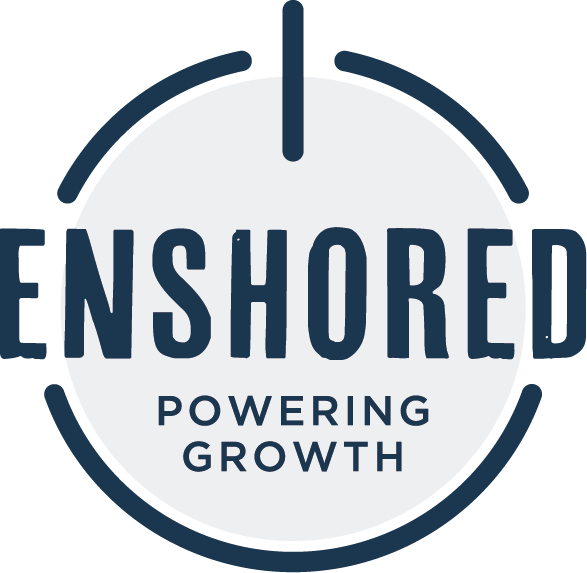Taking too long? Close loading screen.


Are you struggling to keep up with your business’s rapid growth? Overwhelmed by high workloads or lacking specialized skills in your team? Outsourcing can be your game-changer. At Enshored, we understand how to turn outsourcing into a strategic advantage, helping you scale operations, enhance efficiency, and cut costs.
In this guide, we’ll walk you through everything you need to know about outsourcing. From recognizing the need to outsource to choosing the right partner and maintaining control, we’ve got you covered. Let’s dive in and explore how you can leverage outsourcing to propel your business forward.
Outsourcing involves hiring another company to handle certain tasks or services, often to save money or access specific expertise. For businesses, it’s a strategy to optimize resources and focus on core activities.
Outsourcing can be more cost-effective than managing tasks in-house. It allows companies to leverage specialized skills without long-term commitments, enabling them to concentrate on their main areas of expertise, leaving non-core tasks to specialists. These benefits lead to higher efficiency and better outcomes when outsourcing is done wisely.
Companies outsource a wide range of services, including:
Outsourcing these services helps businesses operate smoothly while focusing on their primary objectives.
Deciding whether to outsource involves understanding your needs and how outsourcing fits into your growth plans. Enshored can help you navigate this decision.
Here are some indicators that it might be time to consider outsourcing:
Recognizing these signs early can prevent operational bottlenecks.
Before deciding to outsource, weigh the pros and cons. Outsourcing can often be more cost-effective than hiring in-house for specialized roles, allowing your team to concentrate on their primary tasks, driving growth. Additionally, you can tap into a global pool of expertise. Evaluate these factors against your company’s internal capacities to make an informed decision.
Cost is a significant factor, but it shouldn’t be the only consideration:
Weighing these considerations will help you balance cost implications with the need for high-quality service.
Selecting the best partner for outsourcing is crucial. It’s about finding a teammate who understands your business and aims for success.
Several key aspects should influence your decision:
Each factor plays a crucial role in ensuring a successful partnership.
Consider the partner’s location, expertise, and experience in your industry. These factors can impact the effectiveness of your outsourcing efforts.
Cultural compatibility and language skills are essential for smooth interactions and a better overall experience.
Assess their technical capabilities and problem-solving skills, including ensuring they have the necessary tools for excellent service, investing in ongoing staff training, and being proactive in addressing and resolving issues. Choosing the right outsourcing partner significantly impacts your ability to deliver outstanding service. At Enshored, we strive to meet and exceed our clients’ goals.
Creating an efficient outsourcing strategy is key to ensuring that your outsourcing efforts are successful. This involves balancing cost-effectiveness with high-quality service.
An effective strategy includes several essential components:
These elements form the foundation of a strategy that will help you get the most out of outsourcing.
It’s crucial to set clear objectives and expectations from the start. This involves defining your goals and making sure your outsourcing partner understands them. Effective communication is key to ensuring both parties are aligned.
KPIs are vital for measuring the success of your outsourcing efforts. Common KPIs include:
By establishing these indicators early on, you can ensure your outsourcing partner is aligned with your expectations and working towards your business objectives.
Effective communication is the backbone of any successful outsourcing strategy. Establish clear channels of communication and escalation pathways for addressing issues. This ensures that any challenges can be dealt with swiftly and efficiently, minimizing the impact on your business.
Regular check-ins, clear escalation paths, and open lines of communication are critical components in creating an efficient and effective outsourcing strategy that benefits both your business and your customers.
Implementing the outsourcing process is where your plans and strategies become actions. Here are key aspects to consider for a smooth transition.
Ensure that both parties understand and agree to the legal and contractual obligations. Key areas include:
These agreements lay the foundation for a successful partnership.
Bringing the outsourced team up to speed with your company’s products, services, and standards is critical. Focus on:
This ensures the team can provide the best possible service.
Regularly monitor the process to identify and address issues early on. This involves regular check-ins to review performance metrics and feedback. Additionally, being flexible and adjusting strategies based on real-time insights ensures high-quality service aligned with your evolving needs.
Trial periods and pilot projects offer a low-risk way to test the effectiveness of outsourcing. They provide insights into the dynamics between your company and the outsourcing partner, performance data to fine-tune operations before a full-scale rollout, and feedback opportunities to improve communication, processes, and training. These stages are invaluable for setting the stage for a successful long-term partnership.
Maintaining control over the outsourcing process ensures that your business remains aligned with its goals. Here’s how we manage it.
Trust is essential, but verification is crucial. Regularly check on the outsourced team to ensure they meet high standards. We do this through meetings to discuss progress and address issues, quality audits to review interactions and ensure they meet expectations, and training sessions to continuously improve skills. These steps help maintain quality service.
Conflicts are inevitable, but how they are handled sets successful partnerships apart. Our approach includes immediate escalation for issues that can’t be resolved initially, clear resolution processes outlined from the start to avoid surprises, and feedback loops to learn from each conflict to improve processes. This helps quickly resolve conflicts and prevent future issues.
Protecting sensitive information is a top priority. We ensure strict data access controls, limit who can see what, and provide regular security training to prevent data breaches. Compliance with data protection laws keeps us and our customers safe. This builds trust and protects our reputation.
Maintaining control while outsourcing is essential for success. At Enshored, we implement rigorous processes and checks to ensure smooth and secure operations, providing excellent service while safeguarding interests.
Once outsourcing is in place, it’s crucial to evaluate its success. Here are the best ways to measure and assess your outsourcing efforts.
Measuring success involves looking at several key areas. Important metrics include response time, quality of service, and cost savings. Analyzing these metrics provides a clear picture of performance and improvement areas.
Feedback is invaluable for assessing success. It provides direct insights to understand what clients and stakeholders think about the service, identifies trends to highlight common issues or praise, and helps adjust strategies to improve satisfaction. Both positive and negative feedback are essential for improvement.
Consider these factors when deciding on your outsourcing relationship:
Based on these, decide whether to continue, expand, or end the partnership. Evaluating outsourcing success is an ongoing process. By focusing on performance metrics, feedback, and cost-benefit analysis, you can make the best choices for your business.
Outsourcing, when done right, can be a powerful tool for enhancing your business efficiency and achieving sustainable growth. At Enshored, we believe in forming partnerships that align with your goals and values, ensuring you get the most out of your outsourcing efforts.
Remember, successful outsourcing is a continuous journey of improvement and adaptation. Choose a partner committed to your success, like Enshored, and together we can achieve great things. Ready to take the next step? Contact Enshored today and let’s start transforming your operations.
Anticipating growth?
Access the tools, tech & team you need to scale globally.

Serious about scaling?
One call is all it takes to know if we’re a fit.
© 2024 Enshored · Privacy · GDPR · California · Cookies · Marketing by Klicker